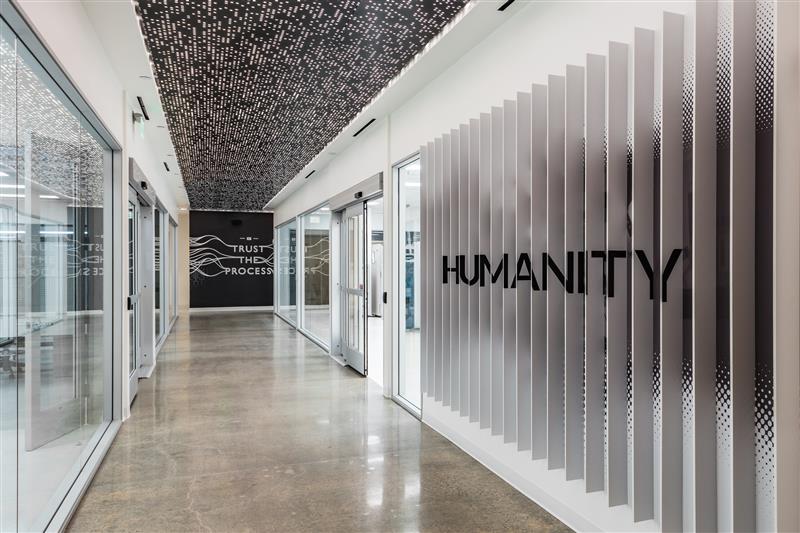Walk into almost any high-end hotel, and you’re instantly greeted—not just by a concierge or plush furniture—but by a carefully curated scent. It’s subtle, but powerful. It says: “Welcome. You’re somewhere special.”
The first time I really noticed this was in 2006, stepping into a Westin hotel in Boston. The smell stopped me in my tracks. Crisp, calming—what was that? Turns out it was their signature White Tea scent. (I could buy it in the gift shop!). That moment lit a fire. If scent could make me feel this way in a lobby, what could it do in a workplace?
We’re in a new era of workplace design—one that finally embraces the full spectrum of our senses. Touch, scent, sound, even taste and sight in new and unexpected ways. And as the lines between hospitality and the office continue to blur, designers are asking better questions: What do people want to feel when they come to work? Can we make an office as immersive and memorable as a boutique hotel or destination restaurant?
Turns out, we can. We already are.
The Future Is Fragrant — and Memorable
Let’s start with scent. It’s the fastest route to emotion. And it’s the most underleveraged, inexpensive tool in the workplace design toolbox.
Most offices don’t have a scent identity. Or if they do, it’s the smell of dry-erase markers, breakroom coffee, or a co-worker’s microwaved lunch. But what if, like in a hotel, you could walk into an office and immediately associate it with a distinctive, mood-lifting fragrance? Better yet—what if you could take it home with you? A candle, spray, or scratch-n-sniff wallpaper?
That’s not just hospitality. That’s branding. That’s memory-making.
Sound can do the same. A fav hotel in Rome had the perfect playlist—modern, chic, irresistible. I inquired at the front desk —they suggested I purchase the CD. That music became part of my experience, an emotional connection to this stunning hotel. That’s what offices should be doing too. Not just quiet background noise, but intentionally layered soundscapes that welcome, focus, energize.
We’re designing workplaces where these layers come together. One recent project explored “Seasons of the Sea,” with each building reflecting a different coastal state: fog, upwelling, oceanic calm. In the “Upwelling” building, the lobby mimicked a San Francisco fog experience—visually, acoustically, and olfactorily. Layers of perf metal & filmed glass suggested mist. A foghorn soundscape set the mood. We even considered diffusing a salty marine scent to make this ocean experience feel immersive.

Immersive Doesn’t Mean Expensive
Some of the most memorable design elements are subtle—and surprisingly affordable.
Restrooms, for instance, are one of the rare places where people expect a sensory upgrade. Scented soap and lotion are small touches that deliver oversized impact. Scent becomes a memorable experience you take with you—and might be the reason for a return trip.
Lighting is another powerful (and budget-friendly) layer. I once created an experience for New Balance that highlighted their new high-visibility gear. The experience simulated a nighttime run through a forest trail. This dark chamber featured black lights, forest sounds, pine scent, and underfoot textures that felt like a forest floor. Was it dramatic? Yes. But also surprisingly simple to assemble. It worked because the senses were layered.
Even a basic RFID badge can elevate the experience. At the Olympic & Paralympic Museum, visitors wear badges that activate personalized greetings at each exhibit. Imagine that in a workplace: “Good morning. Your first meeting is in 30 minutes—and yes, there’s still time for coffee.”
All Five Senses—But Not All at Once
Of course, not everyone wants all five senses engaged at once. Neurodiversity is real. So is personal preference. Great sensory design is about flexibility. Thoughtful layers, not overwhelming inputs. We need to design for the edges—those with the highest sensitivity and the lowest tolerance—so everyone can thrive.
The goal isn’t to bombard. It’s to create an emotional connection with an important place. To evoke a sense of joy, wonder, or calm.

Offices Could Use a Little Hotel Magic
If more offices embraced the logic of hotels and restaurants, we’d start to see:
-
- Signature scents tied to brand identity
- Playlists that shift energy throughout the day
- Personalized greetings and intuitive wayfinding
- Lounge areas that feel more like lobbies than waiting rooms
- Touchpoints you can take home (yes, even the soap)
And most importantly, we’d stop designing spaces purely for function—and start designing them for feeling. Because workplaces aren’t just where we complete tasks. They’re where we build culture, spark ideas, and spend a major chunk of our lives.
So, the next time you step into an office and catch yourself smiling at the scent or swaying to the background music—you’ll know: it’s not an accident. You’re in a 5-star sensory workplace—and it smells amazing.

